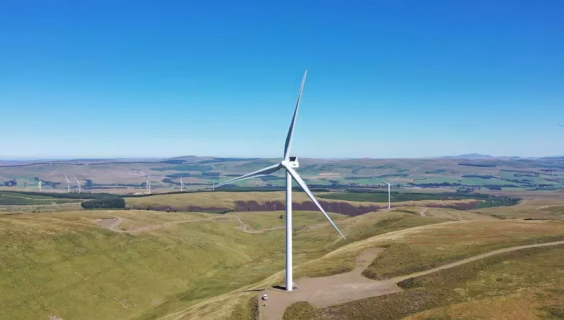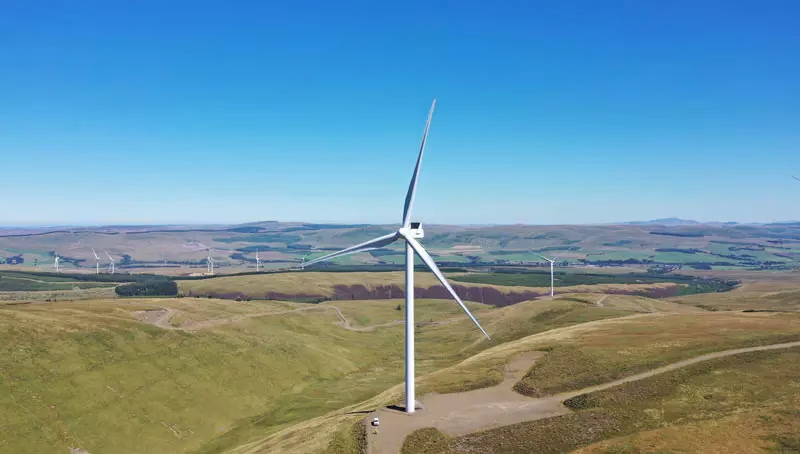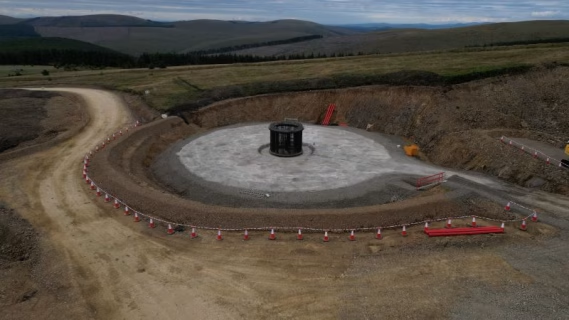Updated on 3rd October 2025 – The £400 million Sanquhar II Wind Farm has achieved a key construction milestone with the successful first pouring of concrete on turbine foundations. Led by principal contractor Jones Bros Civil Engineering UK, the development marks the beginning of major structural works on what will become the UK’s fourth largest wind farm.
The 44-turbine scheme, located across Dumfries and Galloway and East Ayrshire, is designed to generate enough clean electricity to power more than 335,000 homes each year. Jones Bros, supported by Cambrian, carried out the first pour using two on-site batching plants, reducing vehicle movements and streamlining delivery of the ambitious programme.
Project manager Jonathan Maitland highlighted the significance of the milestone, noting the dedication of a 100-strong workforce that is set to double as activity intensifies. “Completing the first pour is always a special moment on wind farm schemes,” he said.
Upcoming works include constructing access tracks, crane hardstandings for turbine installation, and two substation platforms to enable future power export. With first generation expected in 2027, the milestone signals major progress toward bringing this landmark renewable energy project to life.
Reported on 21st Augsut 2025 – After nearly a decade of meticulous planning, construction has officially commenced on a landmark renewable energy project in southern Scotland. The Sanquhar II Community Wind Farm, a sprawling 44-turbine development, is poised to become the UK’s fourth-largest onshore wind farm upon its completion. Developers CWP Energy have confirmed that the project is on track to become operational by August 2026, at which point it will generate enough clean electricity to power approximately 335,000 homes. This significant undertaking not only marks a major step forward in the nation’s green energy ambitions but also promises a substantial economic uplift for the region.
A Major Boost for the Local Economy
The economic implications of the Sanquhar II project are truly transformative, with a projected local investment exceeding £800 million over its 40-year operational lifespan. Furthermore, the construction phase itself represents an immediate £400 million injection into the Scottish economy. This initial stage is set to create hundreds of jobs, with a strong commitment to local hiring. Furthermore, Huw Jones, chairman of the contracted Jones Bros Civil Engineering UK, highlighted that nearly 50% of the current workforce is sourced from the local area. Additionally, they provide a direct and tangible benefit to the communities in Dumfries and Galloway and East Ayrshire.

![]()
Powering a Greener Future
Beyond the economic advantages, the environmental impact of the wind farm is profound. The project will feature state-of-the-art V162 turbines from Vestas, a leader in wind technology. Once fully operational, the farm is expected to offset an incredible 540,000 tonnes of carbon dioxide every single year. Further, this plays a crucial role in Scotland’s fight against climate change. What’s more, this development was briefly paused in 2023 due to tax uncertainties; however, a recent decision by the UK Government to abandon its “zonal energy pricing” plans provided the stability needed for the project to finally move forward, ensuring its contribution to a more secure, home-grown energy supply.
A Strategic Win for UK Energy Security
Ultimately, the greenlighting of Sanquhar II is a testament to a renewed confidence in the UK’s renewables sector. A similar project, the Neart na Gaoithe (NnG) Offshore Wind Farm which was recently unveiled, adding to the confidence. Rod Wood, director of CWP Energy, emphasized that onshore wind remains one of the most cost-effective forms of electricity. Additionally, delivering excellent value to consumers. The project has garnered support from both the Scottish and UK governments. They see it as a vital component in achieving national clean power goals. In addition, as construction ramps up, the wind farm stands as a powerful symbol of collaboration and a critical step toward establishing Scotland as a true renewables powerhouse. Moreover, enhancing the UK’s overall energy security for decades to come.
Project Factsheet
Project and scale: Construction has started on the Sanquhar II wind farm in southern Scotland, which will be the UK’s fourth-largest onshore wind farm.
Operational Timeline: The 44-turbine farm is scheduled to become fully operational by August 2026.
Power Capacity: It will generate enough electricity to power approximately 335,000 homes.
Project Team: The project is led by developer CWP Energy, with Vestas supplying the turbines. Additionally, Jones Bros managing civil engineering.
Immediate Investment: The construction phase represents an immediate £400 million investment into the Scottish economy.
Long-Term Investment: Over its 40-year life, it’s expected to deliver more than £800 million in local investment.
Job Creation: The project will create hundreds of jobs, with nearly 50% of the construction workforce being hired from the local area.
Environmental Impact: The farm is projected to offset about 540,000 tonnes of carbon dioxide each year.
Political Context: The project was enabled after the UK Government scrapped its “zonal energy pricing” plan, which provided investor certainty.
Strategic Goal: The development is a key step towards UK energy security and Scotland’s ambition to be a renewables powerhouse.


